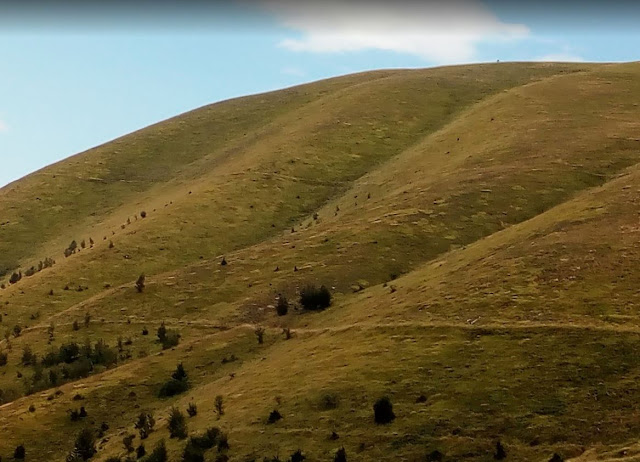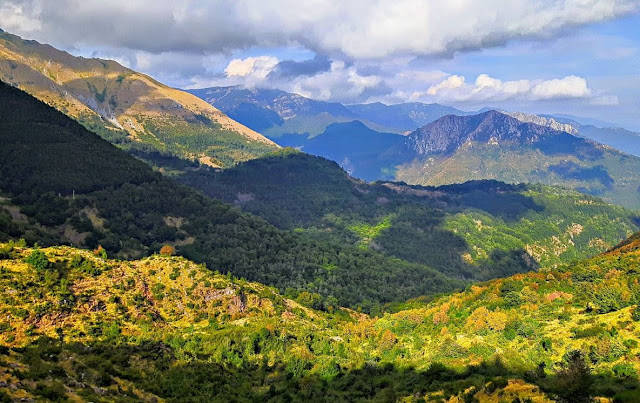Prato Fiorito
English after Italian text
Il monte Prato Fiorito (1297 mtr) domina l'entroterra di Bagni di Lucca. La montagna colpisce perché non c'è vegetazione. In primavera, questa montagna sterile è completamente ricoperta di fiori selvatici in una paletta di molti colori.
Ci sono molte leggende sul Prato Fiorito, che ha suscitato molta immaginazione grazie alla sua forma speciale. Ad esempio, in La notte di San Giovanni (la notte di San Giovanni) il diavolo e le streghe si radunerebbero su questa montagna e si girerebbero come un vento di uragano. Per secoli, questa notte è stata un simbolo di magia, misteri e superstizioni e viene celebrata ogni anno in Toscana.
Chi vuole fare un'escursione a Prato Fiorito parte da Bagni di Lucca e si dirige verso Montefegatesi. Un viaggio di circa 25 minuti. Dopo una tortuosa strada di montagna di circa 16 chilometri vedrete i cartelli gialli di Prato Fiorito. Prima di lasciare la strada principale e gli ultimi tre chilometri la strada in parte non asfaltata ma ben percorribile fino ai piedi della montagna, vedrai uno scorcio dell'incantevole villaggio di Montefegatesi sulla sinistra. Nell'ultima parte della strada ci sono alcune vecchie case degli ex pastori di Albereta. (Il nome di quest'area).
Una croce indica che hai raggiunto la fine del percorso in auto. Da qui puoi percorrere il sentiero attraverso l'erba alta. Sali fino alla cima di 200 metri e sei costantemente circondato da splendidi panorami. In alto, il cliché "In cima al mondo" ti attraverserà. Per coloro che vogliono camminare più riparati e non vogliono fare la ripida salita, possono anche camminare intorno alla montagna. Questo percorso dura circa quattro ore prima di arrivare nel villaggio successivo. Con questa passeggiata è utile guidare due auto. Parcheggiare un'auto al punto finale di Cembroni e successivamente prendere la prima auto al punto di partenza.
Altrimenti c'è una lunga passeggiata sulla strada principale. La strada non è contrassegnata da numeri, ma il percorso è ben mantenuto, quindi si tratta di seguire la strada. Il raduno di mountain bike si svolge su questa strada ogni anno.
Ampia varietà di piante e alberi
Su questa rotta è possibile vedere una grande varietà di piante e alberi. Coloro che sono fortunati vedranno anche la fauna selvatica. Durante la nostra passeggiata, ad esempio, un enorme uccello rapace si è tuffato nell'erba proprio davanti a noi per afferrare un metro e mezzo di manichetta. La coppia volò via, lottando.
Timo selvatico, ginestra, rosa selvatica, papaveri, gigli, orchidea selvatica, narcisi, menta e nontiscordardime crescono sul ciglio della strada.
Lungo la strada ci sono diverse capanne di pietra vuote. Alcuni sono stati rinnovati e temporaneamente occupati dagli italiani nei mesi estivi. L'ultimo residente permanente di Prato Fiorito fu Giuseppe, un eremita / pastore. È morto nella sua cabina diversi anni fa, circondato dal suo gregge di capre e di cani fedeli, senza aver mai vissuto nella civiltà.
Ci sono un certo numero di torrenti montani lungo la strada. Puoi bere l'acqua, anche se ti consiglio di verificare se qualcosa di vivo scorre nella bottiglia.
La vegetazione più suggestiva sono gli antichi castagni. Durante il percorso ci sono diverse selva catagnile, boschi coltivati tradizionalmente con boschi di castagni. In passato, queste foreste erano piantate come un frutteto con l'obiettivo di produrre castagne per il cibo. Gli alberi più spessi risalgono al 15 ° secolo. La circonferenza del tronco più larga non è inferiore a 7 metri. Non sono sequoie ma questa dimensione fa sicuramente impressione. La maggior parte dei castagni un tempo erano colpiti da un fulmine, ma ciò non ha impedito agli alberi di crescere ulteriormente. Durante la seconda guerra mondiale, la castagna era l'unico cibo per i partigiani (i combattenti della resistenza contro i tedeschi) che si nascondevano nelle montagne. A quel tempo, i piatti di castagne erano il cibo povero della popolazione. Dopo la guerra, i boschi di castagni erano deserti.
Gli alberi sono stati protetti dal comune di Bagni di Lucca per alcuni anni. La castagna era una volta l'attività principale di questa zona. Le castagne venivano macinate nella farina. Questo è stato fatto in mulini speciali. Innanzitutto le castagne sono state asciugate. In un cosiddetto metato, una piccola casa di pietra, le castagne venivano arrostite sotto il fuoco fino a quando non erano abbastanza asciutte da macinare.
Questa antica tradizione è ancora onorata durante l'annuale Sagra di Castagne, la festa delle castagne. Durante questo festival all'aperto, la popolazione prepara tutti i tipi di piatti a base di farina di castagne. Oggi, i piatti di castagne sono prelibatezze molto apprezzate. Ne derivano piatti dolci. O torte salate come il castagnaccio. Ma anche frittelle, pasta fresca o gnocchi freschi, zuppe o pane sono fatti con la farina di castagne.
Altamente raccomandato se ti piace camminare.
Gli alberi sono stati protetti dal comune di Bagni di Lucca per alcuni anni. La castagna era una volta l'attività principale di questa zona. Le castagne venivano macinate nella farina. Questo è stato fatto in mulini speciali. Innanzitutto le castagne sono state asciugate. In un cosiddetto metato, una piccola casa di pietra, le castagne venivano arrostite sotto il fuoco fino a quando non erano abbastanza asciutte da macinare.
Questa antica tradizione è ancora onorata durante l'annuale Sagra di Castagne, la festa delle castagne. Durante questo festival all'aperto, la popolazione prepara tutti i tipi di piatti a base di farina di castagne. Oggi, i piatti di castagne sono prelibatezze molto apprezzate. Ne derivano piatti dolci. O torte salate come il castagnaccio. Ma anche frittelle, pasta fresca o gnocchi freschi, zuppe o pane sono fatti con la farina di castagne.
Altamente raccomandato se ti piace camminare.
Mount Prato Fiorito (1297 mtr) dominates the hinterland of Bagni di Lucca. The mountain is striking because there is no vegetation. In spring, this barren mountain is completely covered with wild flowers in a palette of many colors.
There are many legends about Prato Fiorito, which has aroused a lot of imagination thanks to its special shape. For example, in The night of San Giovanni (the night of San Giovanni) the devil and the witches would gather on this mountain and would turn like a hurricane wind. For centuries, this night has been a symbol of magic, mysteries and superstitions and is celebrated every year in Tuscany.
Those who want to make an excursion to Prato Fiorito start from Bagni di Lucca and head towards Montefegatesi. A journey of about 25 minutes. After a winding mountain road of about 16 kilometers you will see the yellow signs of Prato Fiorito. Before leaving the main road and the last three kilometers of the partly unpaved but well practicable road up to the foot of the mountain, you will see a glimpse of the enchanting village of Montefegatesi on the left. In the last part of the street there are some old houses of the former shepherds of Albereta. (The name of this area).
A cross indicates that you have reached the end of the route by car. From here you can walk the path through the tall grass. Climb to the top of 200 meters and you are constantly surrounded by splendid panoramas. Above, the "On Top of the World" cliche will cross you. For those who want to walk more sheltered and don't want to make the steep climb, they can also walk around the mountain. This route takes about four hours before arriving in the next village. With this walk it is useful to drive two cars. Park a car at the end point of Cembroni and then take the first car to the starting point.
Otherwise there is a long walk on the main road. The road is not marked with numbers, but the path is well maintained, so it is a question of following the road. The mountain bike rally takes place on this road every year.
Wide variety of plants and trees
On this route it is possible to see a great variety of plants and trees. Those who are lucky will also see wildlife. During our walk, for example, a huge bird of prey dived into the grass right in front of us to grab a meter and a half of hose. The couple flew away, fighting.
Wild thyme, broom, wild rose, poppies, lilies, wild orchid, daffodils, mint and forget-me-nots grow by the wayside.
Along the way there are several empty stone huts. Some were renewed and temporarily occupied by the Italians in the summer months. The last permanent resident of Prato Fiorito was Giuseppe, a hermit / shepherd. He died in his cabin several years ago, surrounded by his flock of goats and faithful dogs, without ever having lived in civilization.
There are a number of mountain streams along the way. You can drink water, although I advise you to check if something alive is flowing in the bottle.
The most suggestive vegetation is the ancient chestnut trees. Along the way there are several woods, traditionally cultivated woods with chestnut woods. In the past, these forests were planted as an orchard with the aim of producing chestnuts for food. The thickest trees date back to the 15th century. The circumference of the largest trunk is not less than 7 meters. They are not redwoods but this size certainly makes an impression. Most chestnut trees were once struck by lightning, but this did not stop the trees from growing further. During the Second World War, chestnuts were the only food for the partisans (resistance fighters against the Germans) who hid in the mountains. At that time, chestnut dishes were the poor food of the population. After the war, the chestnut woods were deserted.
The trees were protected by the municipality of Bagni di Lucca for a few years. Chestnuts were once the main activity of this area. Chestnuts were ground in flour. This was done in special mills. First of all, the chestnuts were dried. In a so-called metato, a small stone house, chestnuts were roasted under a fire until they were dry enough to grind.
This ancient tradition is still honored during the annual Chestnut Festival, the chestnut festival. During this open-air festival, the population prepares all kinds of chestnut flour dishes. Today, chestnut dishes are highly appreciated delicacies. Sweet dishes result. Or savory pies like chestnut. But also pancakes, fresh pasta or fresh gnocchi, soups or bread are made with chestnut flour.
Highly recommended if you like walking.







Comments
Post a Comment